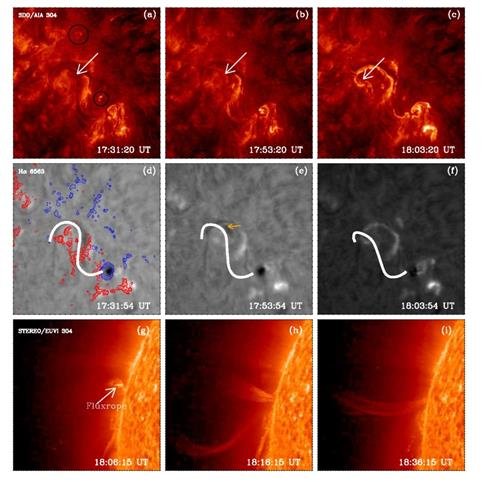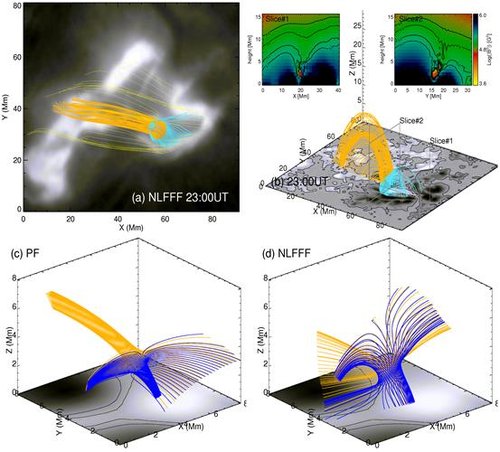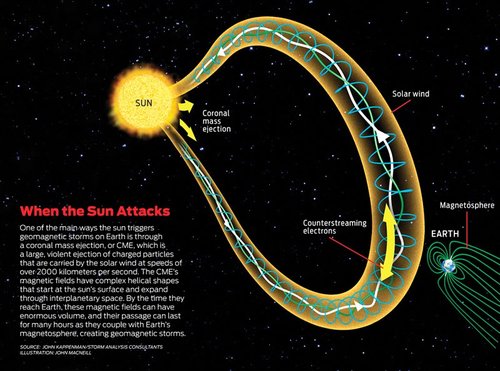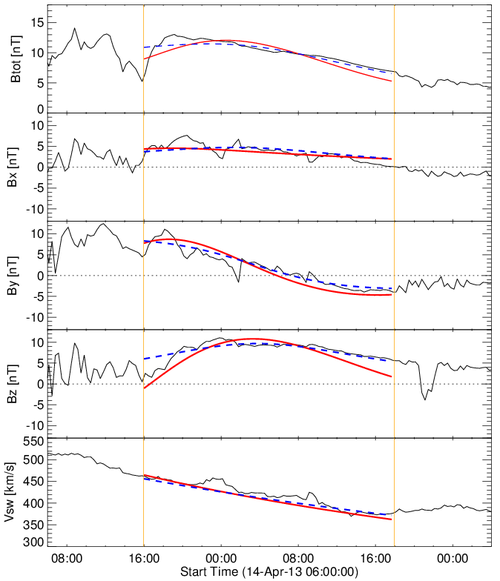Energetic phenomena and space-weather
Activity of the Sun is defined by eruptive events like CMEs and flares occurring in the ARs. Solar flare is a sudden release ofenergy resulting in acceleration of particles and plasma flows and heat. Large flares can be accompanied by highly energetic particles that pose hazards ranging from excessive levels of harmful radiation to disruption and/or destruction of satellites in space. Coronal mass ejections (CMEs) are energetic events in which the plasma that was initially contained in closed coronal magnetic field lines is ejected into interplanetary space. They propagate through the interplanetary medium with speeds up to a maximum of 3000 km/s. Sometimes CMEs precede flares
It is believed that these events occur due to release of energy which is pre-stored in the magnetic field by constantly stressing plasma motions. When the AR magnetic system reached a critical point of stored energy, it releases as an unavoidable eruption. Major fundamental questions in the field of MHD include how these events trigger and what mechanism drives them. High resolution vector magnetic fields, and G-band images from NLST will be useful to help address this phenomena.
Triggering and Driving Mechanisms of Sigmoidal Flux Ropes
During the eruptions, a commonly observed physical structure is magnetic flux rope (Burlaga et al 1988, Lepping et al 1990). It is a volumetric current channel with wrapped fieldlines around its central axis. Its preexistence, formation and role in eruptions are not well understood because it is believed that magnetic reconnection plays the main role and flux rope is treated as secondary.

3D Magnetic field of ARs and null points
Direct measurements of the coronal magnetic fields are very difficult due to lack of spectral line, weak magnetic fields, and high temperatures. Extrapolation is a numberical technique to reconstruct coronal magnetic field of ARs using photospheric magnetic field observations as boundary condition. Since the corona is dominant of magnetic field, a force-free field model is a valid assumption. Recent studies laid foundations to follow the evolution of coronal magnetic field corresponding to the changing photospheric field. Since the observations are static in nature, the evolution is refered to as quasi-static neglecting any dynamic evolution.

A flare is a onset of reconnection at a coronal location where the magnetic fields of opposite direction cut and paste to a different configuration. Those locations are void of magnetic field refering "null points" surrounded by sharp gradients of field known as "current sheets". Reconstructing time series of coronal field by extrapolation model enables to study the null point formation, locations of coronal currents where reconection takes place, and the topological changes in the AR magnetic structure. Recent such investigations reveal "fan-spine" topology with null point in an AR magnetic structure harboring X1.5 flare. The fan separatrix acts as a channel for downward ejecting plasma from coronal null and subsequent formation of flare ribbons.(Figure 10). NLST's high sensitive and sub-arcsecond resolution observations improve the modeling to couple coronal layers and their magnetic role in eruptions.
In-situ magnetic field and space-weather

Magnetic clouds (MCs) are large scale, organised magnetic structures in interplanetary space which are observed in situ as interplanetary coronal mass ejection (ICMEs).They are generally preceded by the occurrence of major coronal mass ejections (CMEs) at the Sun. It is now believed and shown from a variety of independent studies that MCs are magnetic flux ropes (MFRs) of locally straight cylindrical geometry (Burlaga 1988, Shodhan et al 2000, Liu et al 2008, Gopalaswamy et al 2013a). In this picture (see Figure 11), the MC is thought to be part of a large-scale bent flux rope extending from the Sun into interplanetary space with its feet possibly still connected to the Sun (Burlaga et al 1990, Bothmer and Schwenn 1998, Ferrugia et al 1993b, Schwenn 1998, Webb et al 2000). From the point of Sun-Earth connection, a major interesting, important question is how the solar source regions are connected to the in situ MCs, which should lead to important clues on how to forecast the internal magnetic field of CMEs around Earth and other planets.

A MC passage through the space-craft in in-situ is generally identified by a strong magnetic field strength, low plasma β, and rotation of any magnetic field component (reversal of sign during passage). In the flux rope scenario, cylindrically symmetric force-free models fit the in-situ MC observations well (see Figure 12). Since the direction of axial component (southward/northward) in MC decides the occurence of geo-magnetic storms,it is the crucial to determine the orientation of flux rope and the its axial field polarity.
An important scientic aspect is to identify the source AR magnetic signatures in in-situ observations. This will help identifying the instance of the flux rope formation, the sign and quantity of twist, orientation and finally predicting the space-weather. NLST magnetic field observations of the source regions are expected to provide necessary ingredients in the MC field topology and the space-weather.